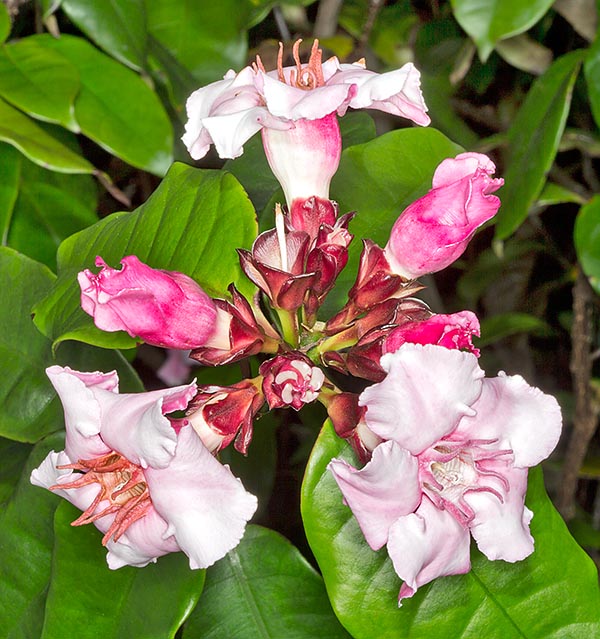Family : Apocynaceae

Text © Pietro Puccio

English translation by Mario Beltramini

Nice but toxic, Strophanthus gratus reaches 18 m with woody climbing stems © Giuseppe Mazza
The name of the genus is the combination of the Greek substantives “στροφος” (strophos) = cord and “ἄνθος” = flower, with reference to the long extremities of the twisted petals, in particular when still in bud, of some species belonging to the genus; the name of the species is the Latin adjective “gratus, a, um” = appreciated, pleasant, with obvious reference.
Common names: climbing oleander, dart vine, poison arrow vine, rose allamanda, spider tresses (English); iné, onayé (Cameroonian); omaatwa (Akan); isa, isa-gidi (Nigerian); gondui, sawai, tsa-wa (Sierra Leonean).
The Strophanthus gratus (Wall. & Hook.) Baill. (1888) is a woody evergreen sarmentose shrub or climber with stems up to about 18 m long and of 8-10 cm of diameter, of brown colour. The leaves, on short petiole, 0,5-1 cm, are simple, opposite, coriaceous, obovate to elliptic-ovate with pointed apex and entire margin, 5-15 cm long and 2-8 cm broad, of intense green colour and glossy. Inflorescences in sessile terminal cymes carrying 3-10 hermaphroditic flowers, on a 0,5-1,2 cm long pedicel, of about 5 cm of diameter, with 5 obovate sepals, 0,8-1,8 cm long, of reddish brown colour, funnel-shaped corolla of white colour suffused of pink with 2,5-4,5 cm long tube and 5 obovate lobes with ruffled margin, 1,5-3,5 cm long and broad, throat with 10 pink lanceolate-linear lobes crown, 0,5-1,5 cm long. The fruits are cylindrical, opposite follicles, 20-40 cm long and of 3-4 cm of diameter, containing 2 cm long fusiform seeds equipped with a 1-5 cm long tuft of hairs at the extremity, which favours their dispersion by means of the wind.
It reproduces by seed in organic loam with addition of sand for a 30% maintained humid at the temperature of 22-24 °C, and by semi-woody cutting.
Particularly ornamental species due to its luxuriant foliage and the delicate coloured, fleshy flowers having the porcelain shine, which emit a pleasant scent recalling the roses’ one, cultivable in the tropical and subtropical climate zones where temperatures of less than +10 °C are exceptional events and of short duration. It requires full sun or slight shade and draining soils rich of organic substance, from slightly acidic to slightly alkaline, may be grown as bush, with proper prunings, or leaning against railings and trellises. Elsewhere, it can be cultivated in pot, using a particularly draining and aerated organic substratum, for being sheltered during the coldest months in very luminous locations, with day temperatures of 20-24 °C and lowest night ones not under the 15 °C. Regular waterings in summer, more spaced in winter, allowing the substratum to partially dry up before giving water again, and fertilizations from spring to autumn preferably with balanced hydrosoluble products with microelements at half of the dosage suggested on the package.
All plant parts are highly toxic, due to the presence of cardioactive glycosides, in particular the ouabain, present in all parts of the plant, but mainly in the seeds, used in the past for poisoning the arrows thanks to the particularly fast lethal effect, by heart failure.
Synonyms: Roupellia grata Wall. & Hook. (1849); Strophanthus stanleyanus Hook (1849); Roupalia grata (Wall. & Hook.) T.Moore & Ayres (1850); Strophanthus ouaboio Holmes (1890); Strophanthus glaber Cornu ex Holmes (1893); Strophanthus gratus Franch. (1893); Nerium guineense Brongn. ex Perrot & Vogt (1913); Strophanthus perrotii A.Chev. (1920); Strophanthus chopraie M.R.Almeida (2001).
→ To appreciate the biodiversity within the APOCYNACEAE family please click here.
